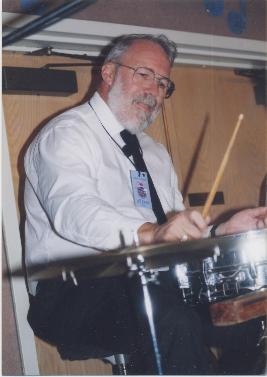CD REVIEW
by Bert Thompson
SALTY BUBBLE (Merry Makers Record Company MMRC-CD-36). Playing time:
46m. 21s.
Salty Bubble†; Snag It*; Willie the Weeper; Far Away Blues; Oriental Man; Weary
Blues; Winin’ Boy*; Sweet Sue*†; Burgundy Street; Blue Bells Goodbye.
Personnel: Ray Ronnei, cornet, vocal*; Jerry Kaehele, trombone; Tom Sharpsteen,
clarinet; Gordon Wilson, piano; Mike Fay, string bass; Vic Loring, banjo.
†Add Walt Sereth, clarinet.
Recorded at The Keg & I, Redondo Beach, California, Nov., 1962.
Two giants of New Orleans-style jazz in California were Ray Ronnei and Tom
Sharpsteen. Sharpsteen passed away in January, 2007, but Ronnei is still with us,
now aged 93 but retired from playing. Both musicians featured a broad vibrato
which, coupled with the tone each achieved on his horn, made them unique and
easily identifiable.
Ronnei has a brassy sound and eagerly attacks each piece, regardless of its tempo,
making for a driving, exciting performance. Eschewing mutes for the most part, he
stays with open horn but not to the detriment of dynamics. Some feel that he his
cornet playing was influenced by that of Albert Brunies, the cornet playing member
of the Brunies family and leader of Abbie Brunies' Halfway House Orchestra.
Sharpsteen, an early disciple of George Lewis, like him enjoyed delivering
arpeggios and runs, especially from notes at the bottom of the chalumeau register to
the top of the upper one. Like Lewis, he also played an Albert system clarinet, but
his had an upturned metal bell, sometimes referred to as an “opera bell.” How this
affected his tone, I can’t say for sure, but I never saw Sharpsteen play any other
horn.
With the exception of Gordon Wilson, who died rather unexpectedly in the summer
of 2005, the others are still extant, and all but Kaehele, who hung up his horn last
year, and Ronnei are still making music.
In true New Orleans style, ensemble is to the fore here, solos being infrequent and
most often backed by the rest of the group. All of the tracks on this CD were
previously issued on a Merry Makers LP, MMRC-118, making for a playing time
that is a bit shorter than is usual on a CD. Although there were a few additional
tracks available, these were not deemed of sufficient quality to include on this
reissue.
The tune on the first track, which is also the title of the album, is named Salty
Bubble; no one seems to know its meaning. I don’t know if anyone has ever asked
Ronnei or if he will remember its provenance. In any event, it is a snappy number
taken at a brisk tempo, and is a tune which might catch on with other bands. It has
been recorded by several bands, including Tom Sharpsteen and His Orlandos, Ted
Shafer’s Jelly Roll Jazz Band, and George Knoblauch’s Black Diamond Jazz Band.
Yet it remains a rather obscure tune.
Most of the others will be familiar to the reader. Far Away Blues does not often get
the outing it deserves, so it is good to see it included. Burgundy Street tends to
speed up, which is unfortunate as it then tends to lose that soulful, mournful
quality that its composer, George Lewis, so beautifully captured on all of his
recordings of it.
Finally, Blue Bells Goodbye, bequeathed to his posterity by Bunk Johnson in his
recording (the first) in 1942, is a 6/8 march. Drums, to me, seem rather essential to
marches, even when they morph from 6/8 to 4/4 as this does. It is therefore
somewhat diminished since the band here lacks a drummer. (In fact,
“drummerless” New Orleans bands are a bit of a contradiction to me altogether, but
that is another topic for another day.) As a point of interest regarding the genesis of
the tune, it seems that Johnson derived much of it from two other tunes, Blue Bell
by Theodore F Morse, 1904, and Bright Eyes (Good Bye) by Egbert Van Alstyne and
Harry H Williams, 1905.
As regards the recording, done by Wilson while sitting playing the piano, it is
surprisingly good for such a method. The vocals are a bit off mic and there is the
inevitable bit of audience noise, but to my mind these do not detract from the
quality of the recording and even enhance it just a little, giving one the feeling of
being present at the gig.
But these cavils do not seriously detract from the overall quality of the music on this
CD. Devotees of the New Orleans style will find much to reward their ears here, so
they should not hesitate to acquire this recording. And for anyone who is
unfamiliar with Ronnei, no better introduction can be found than this disc.
My usual caveat re Merry Makers using adhesive labels is applicable here. The CD
is available from Merry Makers Record Company, 926 Beechwood Circle, Suisun
City, CA 94585, toll-free number in the U.S. 1-866-563-4433. It will also be available
from mail order sites that carry the Merry Makers Records label, as well as at Jelly
Roll Jazz Band gigs.
|
|





